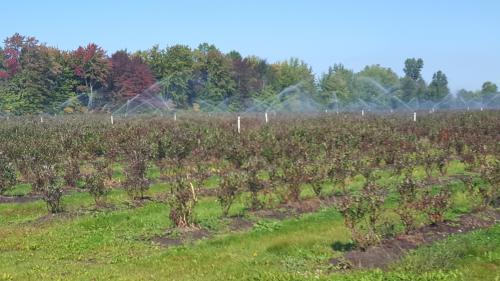Don’t neglect late-season irrigation of blueberries
Be sure your plants have good moisture now as they make flower buds for next spring’s bloom.

It is natural to slow down and relax after blueberry harvest. However, blueberry bushes are producing the flower buds for next year right now. Many shoots have one or two flower buds visible at the shoot tips. The heavy bloom this spring 2017 was due to a long, warm fall with good soil moisture. This long period of mild weather allowed the blueberry plants to produce many flower buds and enter the winter in good shape to withstand the cold, snowy weather in December.
In 2017, summer rainfall has been very spotty. Most of our rain has fallen in scattered showers, so rainfall distribution has been very uneven. Some locations have received adequate rain, but many locations have experienced a dry season continuing through mid-September. Drought-stressed blueberries will begin to shut down early, preparing for winter. Drought stress will reduce flower bud initiation, reducing next year’s bloom and the potential crop in 2018.
It is important to maintain good soil moisture in August and September. While the demand for water declines with cooler and shorter days, there is still a significant demand for water. In well-irrigated blueberry fields, daily water losses during hot, summer days often exceed 0.2 inch per day. During cool, September days, the demand falls to less than 0.1 inch per day. This means the bushes still need a half-inch of water or more every week. Many of our blueberry soils in Michigan only hold 1-2 inches of water in the blueberry root zone. Michigan State University Extension recommends growers maintain 50 percent or more soil moisture to optimize plant health.
The table below shows data calculated from MSU’s Enviroweather’s automated weather stations in Michigan’s blueberry producing region. The table shows the difference between rain received and the estimated amount of water lost through evaporation, plus transpiration from the leaves of the plant (evapotranspiration).
|
Difference between precipitation and potential evapotranspiration (inches) at various southwest Michigan Enviroweather stations, 2017. | |||||
|---|---|---|---|---|---|
|
Time period |
West Olive |
Grand Junction |
South Haven |
Hartford |
Berrien Springs |
|
Aug. 11 to Sept. 11 |
-2.6 |
-0.5 |
0.7 |
-2.7 |
-1.0 |
|
Sept. 1 to 11 |
-0.6 |
-0.2 |
0.8 |
0.1 |
1.3 |
Many totals between Aug. 11 and Sept. 11, and Sept. 1 and 11 are negative, meaning there is a net deficit of water. If you have not irrigated to make up that deficit, soil moisture is inadequate for optimum plant health and floral bud initiation.
Drought stress in the fall can have a direct effect on next season’s crop. Often in the fall, we begin to receive lake effect rains from cool air crossing the relatively warm waters of Lake Michigan and the soils are naturally replenished by rains, but this dry summer is having an adverse effect as the dry summer conditions continue. Having an irrigation system allows growers to apply water when the plants need it and not having to depend of natural rainfall.
Fall irrigation is a good way to guarantee you have a good number of flowers for next spring’s bloom. Fall is when the plant develops the cold hardiness necessary to withstand winter cold. Drought-stressed plants have reduced reserves and cannot withstand as much cold as healthier plants. Having good soil moisture going into the winter also ensures the plant will be better able to withstand winter cold by moderating soil temperatures.

Blueberry irrigation is important all season long. Late-season irrigation ensures healthy, productive plants next year. Photo by Mark Longstroth, MSU Extension.
See these MSU Extension articles for more information:



 Print
Print Email
Email


